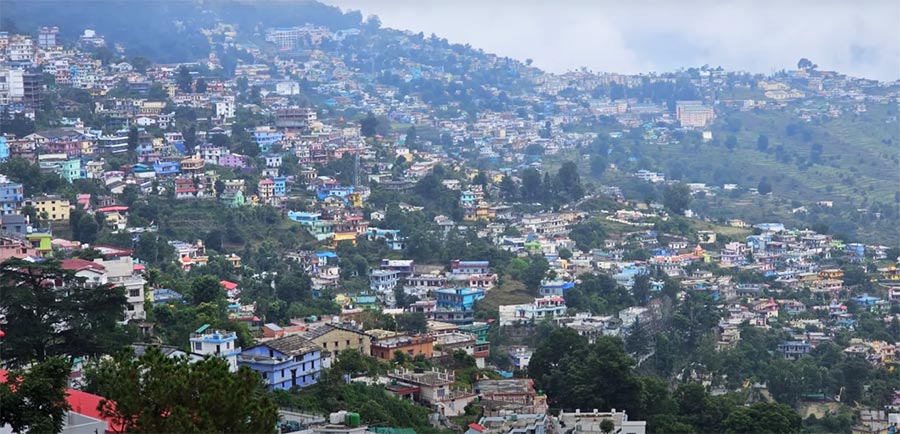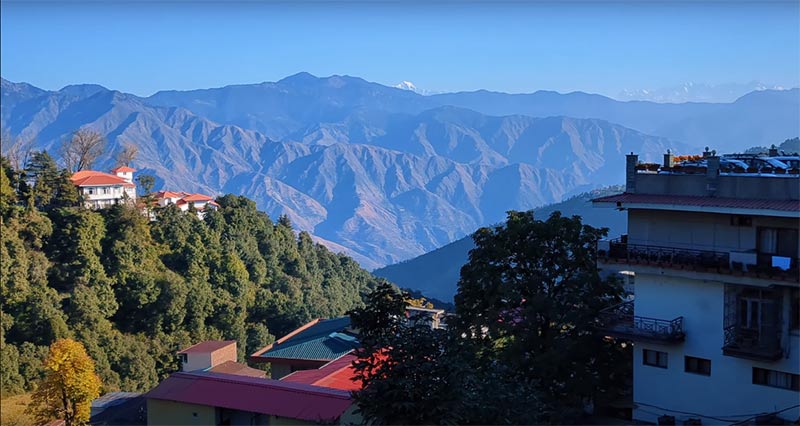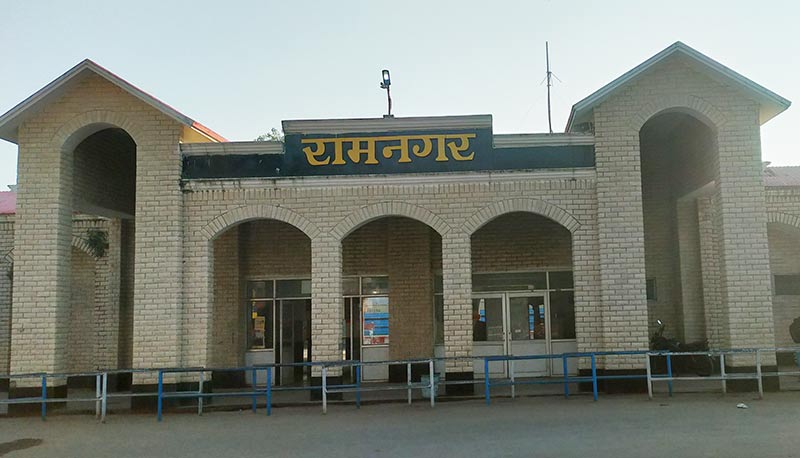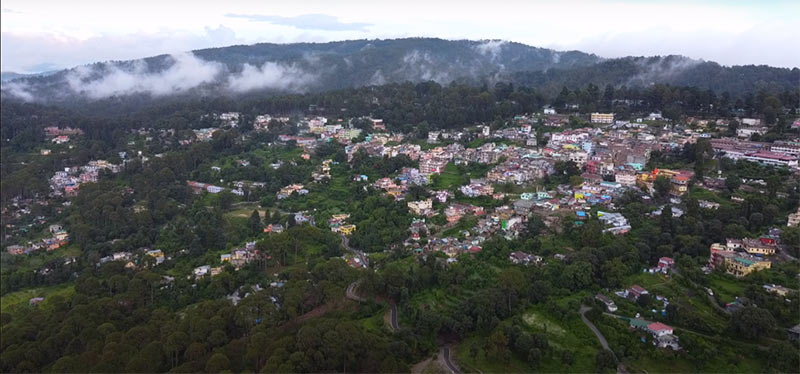Almora derives its name from Kilmora, a type of sorrel plant abundantly found in the region. The plant was historically used for washing utensils at the Katarmal Sun Temple. Nestled on a 5-km-long ridge, Almora boasts a charming setting at the southern edge of the Kashyap hills, resembling a horse saddle. The town provides a picturesque backdrop of the snow-capped Himalayas.

Having once served as the capital of the Chand dynasty rulers, Almora is renowned for its rich cultural heritage, unique handicrafts, and delectable cuisines. Over the years, the town has been a magnet for prominent personalities such as Swami Vivekananda, Rabindranath Tagore, and renowned artists like Uday Shankar, Guru Dutt, and Zora Sehgal, who graced the locale with performances.
Notably, Govind Ballabh Pant, a distinguished freedom fighter and the first Chief Minister of Uttar Pradesh, was born in Almora. The town also takes pride in being the birthplace of Sir Ronald Ross, Nobel laureate for his groundbreaking discovery of the malaria parasite in 1857.
Almora serves as a gateway to various treks, including Jageshwar, Pindari, Mornaula, Mukteshwar, Binsar, and Ranikhet, making it a hub for adventure enthusiasts and nature lovers alike.
What is the optimal time to visit Almora?
Almora, once the summer capital of the Chand Kings of Kumaon, is most enjoyable during the spring-summer season, which spans from March to May. During this period, the weather is pleasantly mild, offering a welcome break from the intense heat prevalent in other parts of the country. It’s an ideal time for outdoor and adventure activities such as trekking and hiking. Many enthusiasts join adventure clubs to embark on exciting expeditions amidst the scenic surroundings.
Conversely, the winter season from November to February is quite cold and may not be the preferred choice for all tourists. However, for off-beat travelers, this season presents unique opportunities. The monsoon season, spanning from July to September, is not recommended for tourists interested in exploring Almora, as it predominantly affects outdoor activities.
In close proximity to Almora, numerous other tourist destinations such as Jim Corbett National Park, Nainital, and Ranikhet are readily accessible. Therefore, if you have a span of 5 to 6 days to dedicate to exploring Uttarakhand, it is advisable to consider including these destinations in your itinerary.
Famous Places to visit in Almora
Here is the list of famous places in Almora
1. ZERO POINT, ALMORA
Situated within the boundaries of the Binsar Wildlife Sanctuary, Zero Point stands as the highest point in the town of Binsar, which itself is perched at an elevation of 2412 meters above sea level. The view of the skies from Zero Point is truly captivating. What makes this place exceptionally unique is that it offers equally stunning vistas during both sunset and sunrise. From Zero Point, one can marvel at a breathtaking 360-degree panoramic view of the Himalayas, including prominent peaks such as Kedarnath Peak, Shivling, and Nanda Devi.
To reach Zero Point, a 1.5-kilometer walk inside the sanctuary is required. Opting for a guided trek to Zero Point is the recommended way to immerse oneself in the lush beauty of the Binsar Wildlife Sanctuary. Additionally, it serves as an excellent location for bird-watching.
2. Jageshwar Temple Almora
Jageshwar, a quaint town nestled in Uttarakhand, resembles a place meticulously crafted for temples. Among the 124 temples in this town, the most frequented is the Jageshwar Mahadev Temple, positioned in the picturesque Jataganga Valley.
Constructed mostly in the 9th century, these temples have remarkably endured the test of time, standing as well-preserved testaments to the rich history of the region. In essence, Jageshwar is a haven for those fascinated by archaeology and eager to delve into the profound mythological beliefs that form the roots of Indian culture. The town is sure to leave you enchanted, igniting an insatiable curiosity to explore its cultural depths.
3. Kasar Devi Almora
Kasar Devi, renowned for its enchanting view of the Himalayas stretching from Nanda Devi to the five snow-capped peaks of Panchachuli, is a picturesque town. At its heart stands the famous Kasar Devi Temple, surrounded by pine and deodar trees that offer a panoramic spectacle of the Himalayas and the Hawabagh Valley. A single road runs through the village, adorned with around 200 houses on each side.
Named after the deity Kasar Devi, the village boasts a history dating back to the 2nd century CE, with its ancient temple at the center. In the 1890s, Swami Vivekananda visited and meditated here, bringing attention to Kasar Devi as a destination. Over time, it evolved into a hub for counter-culture movements in the 1960s.
Kasar Devi’s surroundings are known for an extraordinary geomagnetic field within the Van Allen belt. NASA has extensively studied the formation of this belt. Other renowned locations with similar magnetic field levels include Machu Picchu in Peru and Stonehenge in England.
The annual Kasar Devi fair takes place on Kartik Poornima in the Hindu calendar, drawing visitors who often trek to the temple from the town of Kalimath through charming hillside alleys. Accommodation options are limited but satisfactory.
4. Chitai Golu Devta Temple
The Chitai Temple, locally referred to as Golu Devata Chitai Temple, is situated 9 km from Almora City on State Highway No. 37. Dedicated to Gollu or Goljyu Devta—an incarnation of Lord Shiva in the form of Gaur Bhairav—this temple was constructed during the Chand regime.
Recognized as the dwelling place of the God of Justice, the temple draws people for various reasons, each with its own set of beliefs. As you visit, you’ll be enchanted by the gentle sound of numerous bells swaying in the breeze. Devotees hang these bells as offerings, wishes, or expressions of gratitude, creating a soft, melodic ambiance that resonates far and wide. It’s no wonder the temple is often referred to as the ‘Temple of a Million Bells.
5. Dunagiri Almora
Nestled in the magnificent Kumaoni Himalayas of Uttarakhand, Dunagiri is a small hill town renowned for offering solitude to travelers. Located 43 km from Ranikhet, it stands as a peaceful haven, characterized by natural beauty and a profound sense of detachment from the bustling world. Dunagiri beckons as an enchanting destination where individuals can truly discover themselves.
This village town holds a significant place in Indian mythological history, with many renowned Rishimunis choosing Dunagiri as their abode to attain divine knowledge and share it with the world. Today, Dunagiri is emerging as a new haven for recreation and rejuvenation, inviting tourists to experience the beauty they may have missed until now.
6. Jalna Almora
Nestled away from the bustling tourist hubs, Jalna is a serene village offering a peaceful escape for trekking and exploration amidst the wilderness. Located just a few kilometers from Almora, this scenic village sits at an altitude of 1700 meters, surrounded by the beauty of the Himalayas. Jalna provides a perfect atmosphere for relaxation and is an ideal spot for those seeking a break from the chaos of city life.
This tranquil hamlet, a stone’s throw away from Almora, is a haven for trekking enthusiasts and nature explorers, allowing them to immerse themselves in the natural forest cover of the area. With its charming aura, Jalna attracts travelers in search of both thrill and tranquility, offering a rejuvenating experience away from the hectic pace of urban living.
7. Binsar Mahadev
Situated 33 km from Almora, Binsar is a charming small town in Uttarakhand celebrated for its breathtaking views of the snow-capped Himalayan peaks. Surrounded by lush forests adorned with oak, pine, rhododendrons, and deodar trees, Binsar boasts picturesque green meadows, ancient temples, and the renowned Binsar Wildlife Sanctuary.
A haven for trekkers, Binsar features a Zero Point offering a mesmerizing 360-degree view of the Himalayan ranges, including Nanda Devi, Kedarnath, Shivling, and Trishul. Reaching Zero Point involves a short 2 km trek, providing an opportunity to witness captivating sunrises and sunsets.
Perched at an elevation of 2420 meters, Binsar enjoys pleasant weather year-round. In addition to exploring the Binsar Wildlife Sanctuary, visitors can also discover the spiritual ambience of the Kasar Devi Temple and the Bineshwar Mahadev Temple
8. Katarmal Sun Temple
Perched at an elevation of 2,116 meters above sea level, the Sun Temple in Katarmal village, Uttarakhand, stands as the second most exquisite shrine dedicated to Surya in India. Located approximately 19 kilometers from Almora, this temple complex attracts thousands of tourists and pilgrims annually. The primary temple is devoted to the Surya deity, Vraddhaditya.
This sacred site is bathed in the morning glow as it captures the first rays of the sun. Nestled amidst the Kumaon hills with the Kosi river flowing nearby, the location adds a picturesque charm to the temple complex. Dating back to the 9th century, the temple was constructed during the reign of Katarmalla, a Katyuri ruler. This 800-year-old complex comprises a main temple and 45 smaller shrines. The smaller shrines house idols of Shiva, his consort Parvati, Lakshmana, and Narayana.
9. Lal Bazaar Almora
Lal Bazaar, situated in Almora, is a significant tourist destination offering a variety of shopping delights. Visitors can explore a range of items, from delectable sweets to exquisite brass and bronze souvenirs, all available at reasonable prices.
The star attractions of this shopping hub are the rabbit wool clothes, known for their exceptional softness and warmth, crafted from a special breed of rabbits. In addition, the market features metal utensils and decorative items, making it a popular and diverse shopping destination.
FAQ
Almora derives its name from Kilmora, a sorrel plant abundantly found in the region. This plant was historically used for washing utensils at the Katarmal Sun Temple.
Almora, once the capital of the Chand dynasty rulers, boasts a rich cultural heritage. It has attracted notable personalities like Swami Vivekananda, Rabindranath Tagore, and artists such as Uday Shankar, Guru Dutt, and Zora Sehgal.
The optimal time to visit Almora is during the spring-summer season, from March to May. This period offers mild weather suitable for outdoor activities like trekking. Winter (November to February) is cold, and the monsoon season (July to September) is not recommended for outdoor exploration.
Some notable places include Zero Point in Binsar Wildlife Sanctuary, Jageshwar Temple, Kasar Devi, Chitai Golu Devta Temple, Dunagiri, Jalna, Binsar Mahadev, Katarmal Sun Temple, and Lal Bazaar.
Zero Point, the highest point in Binsar, offers a captivating 360-degree panoramic view of the Himalayas, including peaks like Kedarnath, Shivling, and Nanda Devi. A guided trek is recommended, and it’s known for bird-watching.
Kasar Devi, with its famous temple, offers enchanting views of the Himalayas. It has a history dating back to the 2nd century CE and gained attention when Swami Vivekananda meditated here in the 1890s. The village is known for its unique geomagnetic field.
The Chitai Temple, dedicated to Golu Devta, features millions of hanging bells creating a melodic ambiance. It’s known as the ‘Temple of a Million Bells’ and draws visitors for various reasons, each with its own set of beliefs.
Dunagiri, nestled in the Kumaoni Himalayas, is a peaceful haven known for solitude. It holds significance in Indian mythological history, attracting tourists for recreation and rejuvenation.
Jalna is a serene village near Almora, offering a peaceful escape for trekking and exploration amidst the Himalayan wilderness. It provides an ideal atmosphere for relaxation away from the city’s chaos.
Lal Bazaar in Almora is a significant shopping destination featuring items like rabbit wool clothes, brass and bronze souvenirs, metal utensils, and decorative items at reasonable prices.
You can discover additional Tourist Destinations by clicking the link below
Tourist places, Uttarakhand



